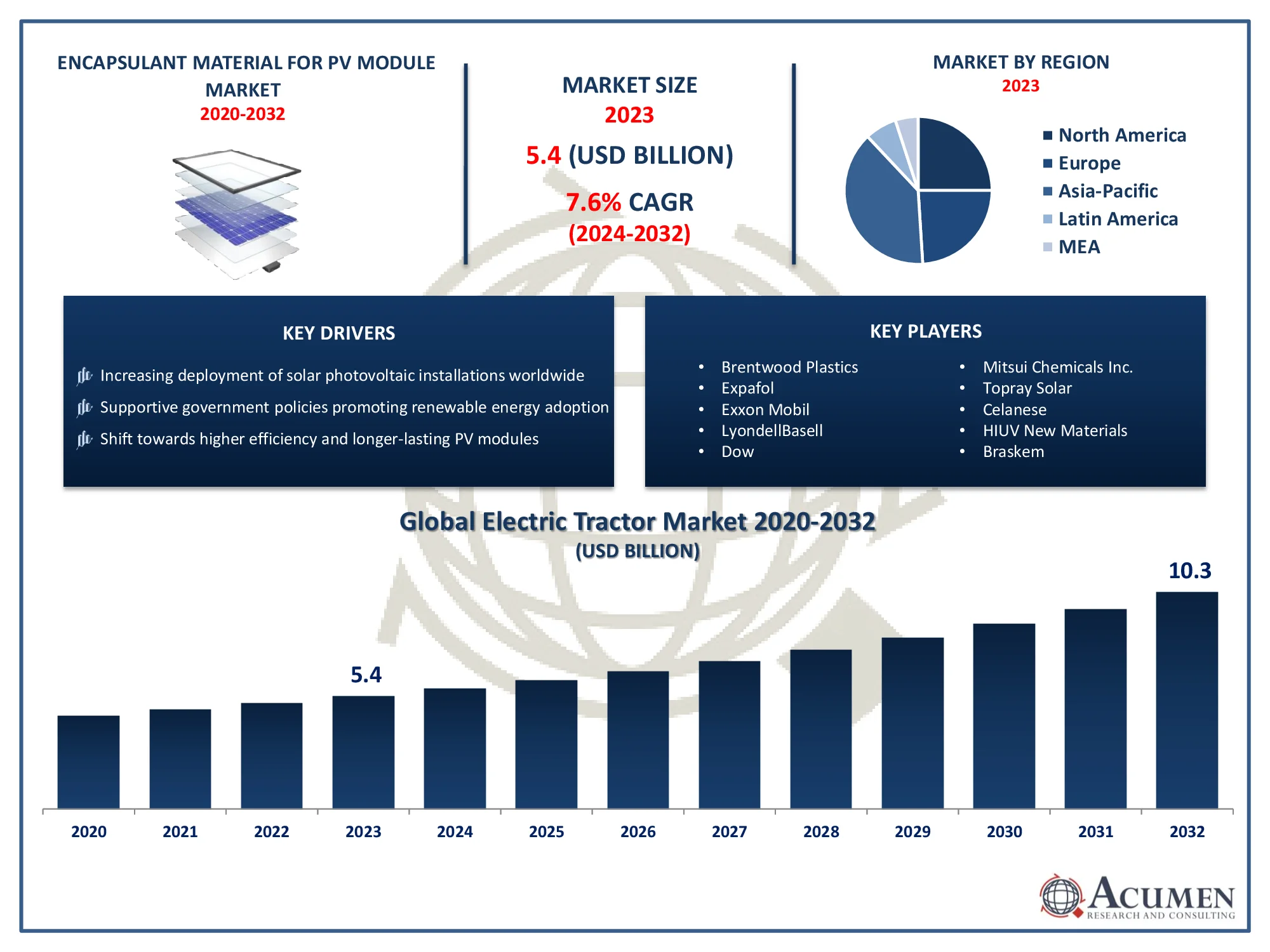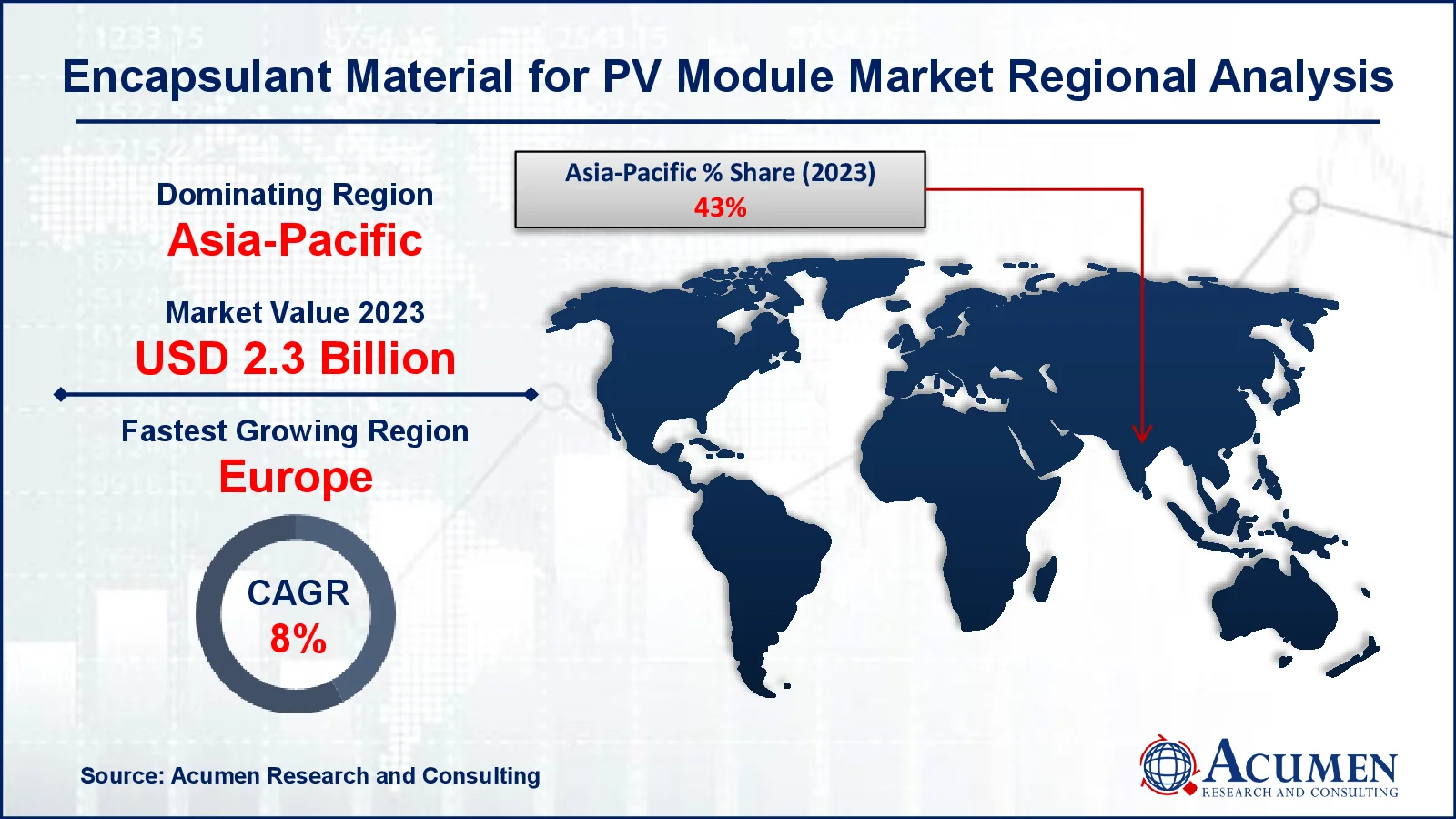Encapsulant Material for PV Module Market | Acumen Research and Consulting
Encapsulant Material for PV Module Market Size - Global Industry, Share, Analysis, Trends and Forecast 2024 - 2032
Published :
Report ID:
Pages :
Format :
The Global Encapsulant Material for PV Module Market Size accounted for USD 5.4 Billion in 2023 and is projected to achieve a market size of USD 10.3 Billion by 2032 growing at a CAGR of 7.6% from 2024 to 2032.
Encapsulant Material for PV Module Market Highlights
- Global encapsulant material for PV module market revenue is expected to increase by USD 10.3 Billion by 2032, with a 7.6% CAGR from 2024 to 2032
- Asia-Pacific region led with more than 43% of encapsulant material for PV module market share in 2023
- Europe encapsulant material for PV module market growth will record a CAGR of more than 8.3% from 2024 to 2032
- By type, the ethylene vinyl acetate (EVA) segment accounted for the largest share of 33% in 2023
- By end-use, the industrial segment has captured more than 42% of market share in 2023
- Increasing deployment of solar photovoltaic installations worldwide, drives the encapsulant material for PV module market value

The encapsulant material used in photovoltaic (PV) modules serves a crucial role in protecting the solar cells from environmental factors such as moisture, UV radiation, and mechanical stress, while also enhancing the module's durability and performance over its operational lifetime. Typically, ethylene-vinyl acetate (EVA) has been the most widely used encapsulant material due to its excellent optical properties, adhesion characteristics, and cost-effectiveness. However, newer encapsulant materials like thermoplastic polyolefin (TPO) and polyolefin elastomer (POE) are gaining traction in the market due to their improved durability, better resistance to potential-induced degradation (PID), and lower processing temperatures, which can lead to reduced manufacturing costs and improved energy yield.
The market for encapsulant materials in the PV industry has been experiencing significant growth in recent years, driven by the increasing deployment of solar photovoltaic installations worldwide. Factors such as supportive government policies, declining costs of solar energy, and growing environmental concerns have spurred the demand for PV modules, thereby boosting the demand for encapsulant materials. Moreover, technological advancements and research efforts aimed at enhancing the performance and reliability of encapsulant materials are further propelling market growth. Additionally, the shift towards higher efficiency and longer-lasting PV modules is driving the adoption of advanced encapsulant materials that offer improved reliability and durability in harsh operating conditions, thereby fueling market expansion.
Global Encapsulant Material for PV Module Market Trends
Market Drivers
- Increasing deployment of solar photovoltaic installations worldwide
- Technological advancements enhancing encapsulant performance and reliability
- Supportive government policies promoting renewable energy adoption
- Growing environmental concerns driving demand for clean energy solutions
- Shift towards higher efficiency and longer-lasting PV modules
Market Restraints
- Fluctuating raw material prices affecting manufacturing costs
- Challenges related to potential-induced degradation (PID) in encapsulant materials
Market Opportunities
- Emerging trends such as bifacial modules and floating solar installations
- Development of self-healing encapsulants and materials with enhanced properties
Encapsulant Material for PV Module Market Report Coverage
| Market | Encapsulant Material for PV Module Market |
| Encapsulant Material for PV Module Market Size 2022 |
USD 5.4 Billion |
| Encapsulant Material for PV Module Market Forecast 2032 | USD 10.3 Billion |
| Encapsulant Material for PV Module Market CAGR During 2023 - 2032 | 7.6% |
| Encapsulant Material for PV Module Market Analysis Period | 2020 - 2032 |
| Encapsulant Material for PV Module Market Base Year |
2022 |
| Encapsulant Material for PV Module Market Forecast Data | 2023 - 2032 |
| Segments Covered | By Material Type, By End Use, And By Geography |
| Regional Scope | North America, Europe, Asia Pacific, Latin America, and Middle East & Africa |
| Key Companies Profiled | Brentwood Plastics, Expafol, Exxon Mobil, LyondellBasell, Dow, Mitsui Chemicals Inc., Topray Solar, Celanese, HIUV New Materials, Braskem, Sumitomo Chemical Co, and Betterial Film Technologies. |
| Report Coverage |
Market Trends, Drivers, Restraints, Competitive Analysis, Player Profiling, Covid-19 Analysis, Regulation Analysis |
Encapsulant Material for PV Module Market Dynamics
Encapsulant material for PV modules is a critical component used to protect and encapsulate the solar cells within the module. The most commonly used encapsulant material is ethylene-vinyl acetate (EVA), which is a transparent, durable, and weather-resistant polymer. EVA encapsulant serves several key functions in a PV module, including providing mechanical support to the solar cells, protecting them from moisture, dust, and other environmental factors, and enhancing the module's optical properties by reducing reflection losses and improving light transmission to the solar cells. Additionally, encapsulant materials play a crucial role in maintaining the structural integrity of the module and ensuring its long-term performance and reliability under various operating conditions.
The encapsulant material market for PV modules is experiencing robust growth driven by several key factors. One significant driver is the rapid expansion of solar photovoltaic installations globally. As governments and industries increasingly prioritize renewable energy sources to combat climate change and reduce carbon emissions, the demand for PV modules and their encapsulant materials has surged. This growth is further propelled by declining costs of solar energy and supportive policies incentivizing solar adoption, particularly in regions aiming for energy independence and sustainability. Moreover, technological advancements in encapsulant materials are fueling market growth by enhancing the performance, reliability, and durability of PV modules. Innovations such as improved resistance to potential-induced degradation (PID), higher thermal conductivity, and enhanced UV stability are addressing critical challenges and driving efficiency gains in solar energy systems.
Encapsulant Material for PV Module Market Segmentation
The global encapsulant material for PV module market segmentation is based on material type, end use, and geography.
Encapsulant Material for PV Module Market By Material Type
- Ethylene Vinyl Acetate (EVA)
- Polyolefins (PO)
- Polyvinyl Butyral (PVB)
- Ethylene Ionomers
- Silicones
- Others
In terms of material types, the ethylene vinyl acetate (EVA) segment accounted for the largest market share in 2023. Historically, EVA has been the dominant material choice for encapsulating solar cells due to its excellent optical properties, adhesion characteristics, and cost-effectiveness. Despite the emergence of alternative encapsulant materials, EVA remains highly favored, especially in mainstream PV module manufacturing. One key driver of the EVA segment's growth is the continued expansion of the solar photovoltaic industry worldwide. As solar energy becomes increasingly competitive with traditional fossil fuel sources, the demand for PV modules encapsulated with EVA continues to rise, particularly in utility-scale and residential solar installations. Additionally, ongoing research and development efforts aimed at improving the performance and reliability of EVA encapsulants, such as enhancing resistance to potential-induced degradation (PID) and extending operational lifespans, are further bolstering market growth.
Encapsulant Material for PV Module Market By End Use
- Commercial
- Residential
- Industrial
According to the encapsulant material for PV module market forecast, the industrial segment is expected to witness significant growth in the coming years. Industrial applications of solar photovoltaics encompass a wide range of installations, including commercial rooftops, ground-mounted arrays, and solar farms. As businesses and industries increasingly adopt renewable energy to reduce carbon footprints and energy costs, the demand for PV modules encapsulated with suitable materials is on the rise. One key driver of growth in the industrial segment is the expanding adoption of solar power by commercial and industrial entities. Large-scale solar installations on industrial facilities and commercial buildings are becoming more commonplace as businesses seek to harness clean energy and achieve sustainability goals. This trend is particularly prominent in sectors such as manufacturing, logistics, and retail, where solar photovoltaics offer significant cost savings and environmental benefits.
Encapsulant Material for PV Module Market Regional Outlook
North America
- U.S.
- Canada
Europe
- U.K.
- Germany
- France
- Spain
- Rest of Europe
Asia-Pacific
- India
- Japan
- China
- Australia
- South Korea
- Rest of Asia-Pacific
Latin America
- Brazil
- Mexico
- Rest of Latin America
The Middle East & Africa
- South Africa
- GCC Countries
- Rest of the Middle East & Africa (ME&A)

Encapsulant Material for PV Module Market Regional Analysis
The Asia-Pacific region has emerged as a dominating force in the encapsulant material market for PV modules, primarily due to several key factors driving growth in the region. One of the primary drivers is the rapid expansion of the solar photovoltaic industry in countries like China, India, Japan, and South Korea. These nations have made significant investments in solar energy infrastructure, driven by government incentives, ambitious renewable energy targets, and increasing environmental concerns. As a result, the demand for encapsulant materials for PV modules has surged in the Asia-Pacific region, creating a thriving market ecosystem. Moreover, Asia-Pacific countries benefit from a robust manufacturing base for solar photovoltaic modules, making the region a hub for PV module production. With a large number of PV module manufacturers concentrated in Asia-Pacific, there is a high demand for encapsulant materials to support the production of solar panels. Additionally, the region's abundant supply of raw materials and skilled labor, coupled with relatively lower manufacturing costs, further contribute to its dominance in the encapsulant material market for PV modules. Furthermore, Asia-Pacific's leading position in the encapsulant material market is reinforced by ongoing technological innovations and research efforts aimed at improving the performance, reliability, and cost-effectiveness of encapsulant materials.
Encapsulant Material for PV Module Market Player
Some of the top encapsulant material for PV module market companies offered in the professional report include Brentwood Plastics, Expafol, Exxon Mobil, LyondellBasell, Dow, Mitsui Chemicals Inc., Topray Solar, Celanese, HIUV New Materials, Braskem, Sumitomo Chemical Co, and Betterial Film Technologies.
Frequently Asked Questions
What was the market size of the global encapsulant material for PV module in 2023?
The market size of encapsulant material for PV module was USD 5.4 Billion in 2023.
What is the CAGR of the global encapsulant material for PV module market from 2024 to 2032?
The CAGR of encapsulant material for PV module is 7.6% during the analysis period of 2024 to 2032.
Which are the key players in the encapsulant material for PV module market?
The key players operating in the global market are including Brentwood Plastics, Expafol, Exxon Mobil, LyondellBasell, Dow, Mitsui Chemicals Inc., Topray Solar, Celanese, HIUV New Materials, Braskem, Sumitomo Chemical Co, and Betterial Film Technologies.
Which region dominated the global encapsulant material for PV module market share?
Asia-Pacific held the dominating position in encapsulant material for PV module industry during the analysis period of 2024 to 2032.
Which region registered fastest CAGR from 2024 to 2032?
Europe region exhibited fastest growing CAGR for market of encapsulant material for PV module during the analysis period of 2024 to 2032.
What are the current trends and dynamics in the global encapsulant material for PV module industry?
The current trends and dynamics in the encapsulant material for PV module market growth include increasing deployment of solar photovoltaic installations worldwide, technological advancements enhancing encapsulant performance and reliability, and supportive government policies promoting renewable energy adoption.
Which Material Type held the maximum share in 2023?
The ethylene vinyl acetate (EVA) type held the maximum share of the encapsulant material for PV module industry.



